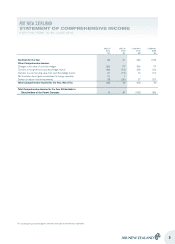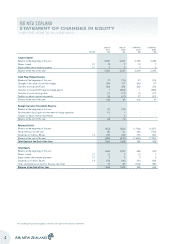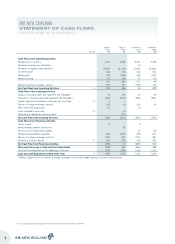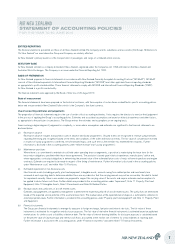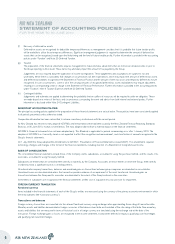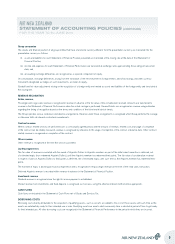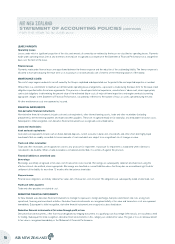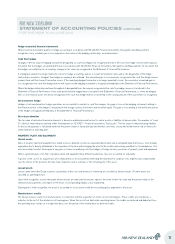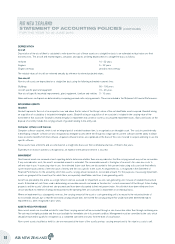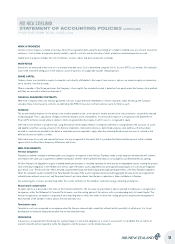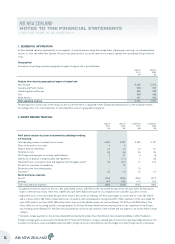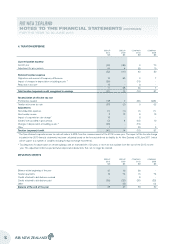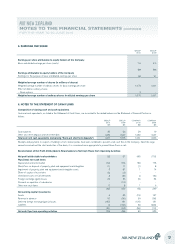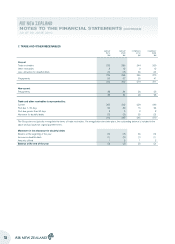Air New Zealand 2010 Annual Report Download - page 10
Download and view the complete annual report
Please find page 10 of the 2010 Air New Zealand annual report below. You can navigate through the pages in the report by either clicking on the pages listed below, or by using the keyword search tool below to find specific information within the annual report.
(f) Recovery of deferred tax assets
Deferred tax assets are recognised for deductible temporary differences as management considers that it is probable that future taxable profits
will be available to utilise those temporary differences. Significant management judgement is required to determine the amount of deferred tax
assets that can be recognised, based upon the likely timing and the level of future taxable profits. Further information is provided in the accounting
policies under “Taxation” and Note 20 Deferred Taxation.
(g) Taxation
The preparation of the financial statements requires management to make estimates about items that are not known at balance date or prior to
the Group reporting its final result. These items may ultimately impact the amount of tax payable by the Group.
Judgements are also required about the application of income tax legislation. These judgements and assumptions are subject to risk and
uncertainty, hence there is a possibility that changes in circumstances will alter expectations, which may impact the amount of deferred tax assets
and deferred tax liabilities recognised in the Statement of Financial Position and the amount of other tax losses and temporary differences not yet
recognised. In such circumstances, some or all of the carrying amounts of recognised deferred tax assets and liabilities may require adjustment,
resulting in a corresponding credit or charge to the Statement of Financial Performance. Further information is provided in the accounting policies
under “Taxation”, Note 4 Taxation Expense and Note 20 Deferred Taxation.
(h) Contingent liabilities
Judgements and estimates are applied to determining the probability that an outflow of resources will be required to settle an obligation. These
are made based on a review of the facts and circumstances surrounding the event and advice from both internal and external parties. Further
information is disclosed within Note 24 Contingent Liabilities.
SIGNIFICANT ACCOUNTING POLICIES
The principal accounting policies applied in the preparation of these financial statements are set out below. These policies have been consistently applied
to all periods presented, unless otherwise stated.
Comparative information has been reclassified to achieve consistency in disclosure with the current period.
Air New Zealand has elected to early adopt all NZ IFRSs and Interpretations that had been issued by the New Zealand Financial Reporting Standards
Board as at 30 June 2010, except as noted below. The early adoption did not have a material impact on the financial statements.
NZ IFRS 9: Financial Instruments has not been adopted early. This Standard is applicable for periods commencing on or after 1 January 2013. The
adoption of NZ IFRS 9 as it currently stands is not expected to affect the recognition and measurement, and classification of amounts recognised in the
Group’s financial statements.
On 1 July 2009 the Group adopted the Amendments to NZ IAS 1: Presentation of Financial Statements (revised 2007). The amendments required
terminology changes and changes in the format of the financial statements, including insertion of a Statement of Comprehensive Income.
BASIS OF CONSOLIDATION
The consolidated financial statements include those of the Company and its subsidiaries, accounted for using the purchase method, and the results of its
associates, accounted for using the equity method.
Subsidiaries are entities that are controlled either directly or indirectly, by the Company. Associates are those entities in which the Group, either directly
or indirectly, holds a significant but not a controlling interest.
All material intercompany transactions, balances and unrealised gains on transactions between group companies are eliminated on consolidation.
Unrealised losses are also eliminated unless the transaction provides evidence of an impairment of the asset transferred. Unrealised gains on
transactions between the Group and its associates are eliminated to the extent of the Group’s interest in the associates.
Investments in subsidiaries are recognised in the financial statements at their cost of acquisition less any provision for impairment.
FOREIGN CURRENCY TRANSLATION
Functional currency
Items included in the financial statements of each of the Group’s entities are measured using the currency of the primary economic environment in which
the entity operates (the “functional currency”).
Transactions and balances
Foreign currency transactions are converted into the relevant functional currency using exchange rates approximating those ruling at transaction date.
Monetary assets and liabilities denominated in foreign currencies at the balance sheet date are translated at the rate ruling at that date. Non-monetary
assets and liabilities that are measured in terms of historical cost in a foreign currency are translated using the exchange rate at the date of the
transaction. Foreign exchange gains or losses are recognised in the income statement, except when deferred in equity as qualifying cash flow hedges
and qualifying net investment hedges.
8
AIR NEW ZEALAND
STATEMENT OF ACCOUNTING POLICIES (CONTINUED)
FOR THE YEAR TO 30 JUNE 2010





